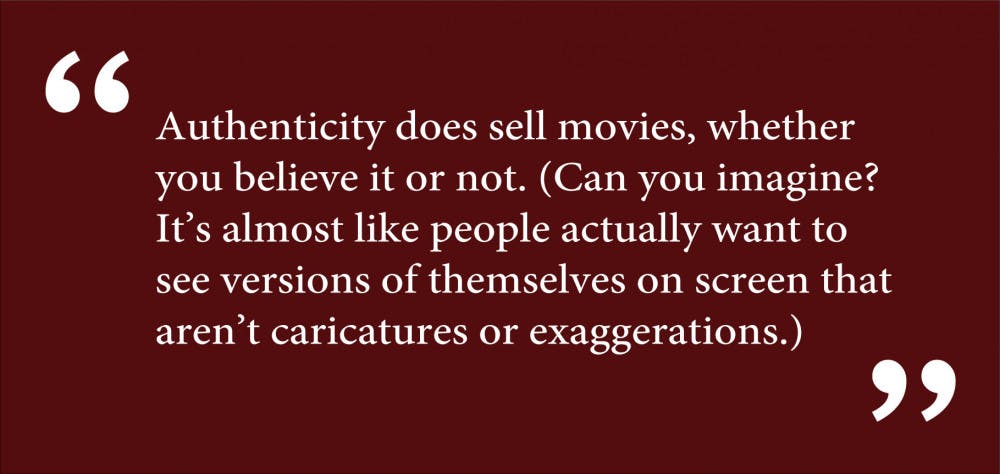When it was announced last week that Chinese actress Liu Yifei would play the titular role in Disney’s live-action remake of “Mulan,” I almost cried with relief. “Mulan” is one of the very few American movies (and by far the only animated one) that I think represents my culture and history well. Keep in mind that the animated movie has a dragon voiced by Eddie Murphy and a matchmatcher by Harvey Feinstein — the bar is not set that high. Even with the casting of the live-action movie, I am still somewhat worried about rumors that the male love interest was going to be replaced by some generic white man, or that the Mandarin used in the film (if we were lucky enough to have any) would be clipped, accented and broken. Despite this caveat, we should take heart in the fact that Hollywood starting to care about accurate representation.
But we still have a lot to wish for in terms of Asian American representation in film. Hollywood has never screamed “cultural representation” in its movies and works, especially for Asians and Asian Americans. I can name three examples from recent years off the top of my head of Asian characters being whitewashed: Scarlett Johansson in “Ghost in the Shell,” Tilda Swinton in “Doctor Strange” and Nat Wolff in the Neflix movie “Death Note.” We are also a group that gets fetishized often and doesn’t really have the history of mobilization and representation within the industry to fight back. As the comedian Ali Wong told the New Yorker, “I think people think that Asian Americans are really good at hive-mentality stuff — you know, like, in entertainment maybe they’re good at ‘America’s Best Dance Crew’ dancing, or, like, tennis — but not at being truly innovative and having something to say that will create a cultural Zeitgeist. What hurts is when I feel like Asian people believe that about ourselves.” It’s not just creativity — I firmly believe that high-profile studios don’t find Asian men attractive enough to lead a movie or Asian women complex enough to be anything but sex objects.
And even when studios cast actual Asian actors as Asian characters, they tend to be token ethnic characters added for entertainment rather than nuance. Take Mantis in “Guardians of the Galaxy.” Or the Vietnamese-American girl, Kelly Marie Tran, in the new “Star Wars” movie. There’s even a new token Asian woman in the “Fantastic Beasts” film in production (I think she’s an exotic werewolf or something equally objectifying). “Avengers: Age of Ultron,” “Sixteen Candles,” “Pitch Perfect.” The list goes on and on. It’s not that I don’t think these actors deserve their breakthrough roles into Hollywood; my question is why many of these characters were given bit roles or only introduced into sequels or blockbusters after the movie series was proven successful. Why weren’t these actors members of the starting cast? Here’s a running joke I hear from family working in Hollywood: “Add enough representation so it sells in China, but make sure it doesn’t have too much representation for China.”
There isn’t enough faith that Asian actors can hold their own, but at the same time, Hollywood loves to pull elements out of East Asian culture for its own purposes. Filmmakers have taken inspiration from concepts from the mecha genre (“Pacific Rim”) to martial arts (“Kill Bill”). I hear the next Wes Anderson movie is set in dystopian Japan. It’s hard as members of the public to discern between real homage to these fields and cheap knockouts designed to make money.
But authenticity does sell movies, whether you believe it or not. (Can you imagine? It’s almost like people actually want to see versions of themselves on screen that aren’t caricatures or exaggerations.) Just look at “Coco,” the new Pixar movie. Sure, it was directed by two white men, but they were smart enough to bring in a full Latinx voice cast, hire cultural consultants and fund enough research trips to Mexico to make me actually believe that they were well-intentioned. The result? The highest-grossing film in Mexico.
So how do we discern where the line is drawn? I think the first step is to think critically about casting and representation. If there is a movie that draws on cultural heritage, are many roles — acting or otherwise — filled with people who have lived through those experiences? Don’t give me that crap about a dearth of talent in certain groups. Contrary to popular belief, there are tons of talented Asian-American screenwriters, actors and entertainment workers who are capable of producing excellent work. They’ve had to rely on other options to promote their visibility, like Youtube, but they are more than capable. I just want to see more of myself on that silver screen.
Movie executives are finally (finally!) betting on movies with central casts made up of people of color. Disney is bankrolling live-action projects of “Mulan” and the “Lion King,” and thankfully realizing that white actors might not be the best idea this time around. We’ve got exciting projects like “A Wrinkle in Time” and the “Black Panther” led by talented black artists. For the first time in a long time, I am excited about the artistic direction in Hollywood — I just hope the institution has the foresight to follow through.
Mark Liang ’19 can be reached at mark_liang@brown.edu. Please send responses to this opinion to letters@browndailyherald.com and other op-eds to opinions@browndailyherald.com.





